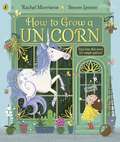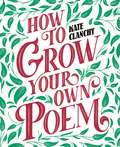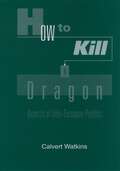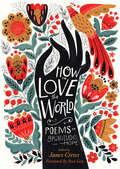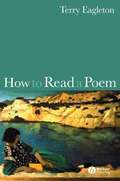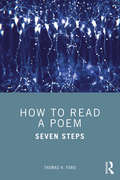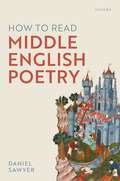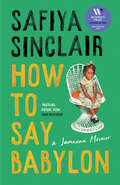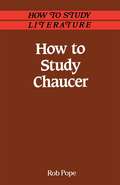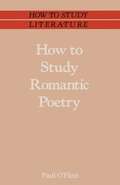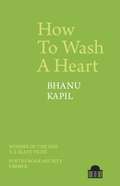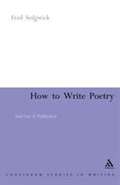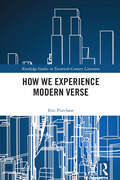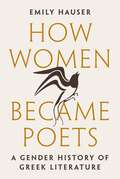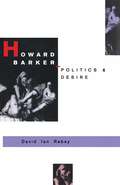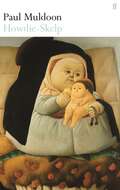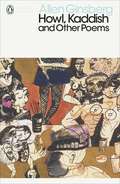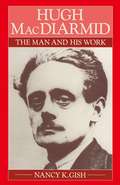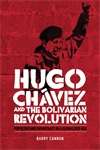- Table View
- List View
How to Grow a Unicorn
by Rachel MorrisroeA rollicking, rhyming read-aloud treat from wordsmith extraordinaire, debut author Rachel Morrisroe, and the ridiculously talented, bestselling Steven LentonWelcome to Mr Pottifer's Parlour of Plants: a magical shop with the most surprising plants you'll ever see!Sarah thinks she's discovered the perfect gift for her garden-loving grandma, but before you can say GARDEN FULL OF UNICORNS, things grow wildly out-of-hand! Live your own hilarious unicorn fantasy in this rip-roaring, rhyming delight from a terrifically talented new picture book author, with illustrations from the brilliant, bestselling illustrator Steven Lenton - illustrator of Shifty McGifty and The Hundred and One Dalmations picture book.
How to Grow Your Own Poem
by Kate ClanchyDo you want to write a poem? This book will show you ‘how to grow your own poem’ . . . Kate Clanchy has been teaching people to write poetry for more than twenty years. Some were old, some were young; some were fluent English speakers, some were not. None of them were confident to start with, but a surprising number went to win prizes and every one finished up with a poem they were proud of, a poem that only they could have written – their own poem.Kate’s big secret is a simple one: is to share other poems. She believes poetry is like singing or dancing and the best way to learn is to follow someone else. In this book, Kate shares the poems she has found provoke the richest responses, the exercises that help to shape those responses into new poems, and the advice that most often helps new writers build their own writing practice.If you have never written a poem before, this book will get you started. If you have written poems before, this book will help you to write more fluently and confidently, more as yourself. This book not like other creative writing books. It doesn’t ask you to set out on your own, but to join in. Your invitation is inside.
How to Grow Your Own Poem
by Kate ClanchyDo you want to write a poem? This book will show you 'how to grow your own poem'… Kate Clanchy has been teaching people to write poetry for more than twenty years. Some were old, some were young; some were fluent English speakers, some were not. None of them were confident to start with, but a surprising number went to win prizes and every one finished up with a poem they were proud of, a poem that only they could have written – their own poem. Kate's big secret is a simple one: to share other poems. She believes poetry is like singing or dancing and the best way to learn is to follow someone else. In this book, Kate shares the poems she has found provoke the richest responses, the exercises that help to shape those responses into new poems, and the advice that most often helps new writers build their own writing practice. If you have never written a poem before, this book will get you started. If you have written poems before, this book will help you to write more fluently and confidently, more as yourself. This book not like other creative writing books. It doesn't ask you to set out on your own, but to join in. Your invitation is inside.
How to Love the World: Poems of Gratitude and Hope
by James CrewsThis beautifully curated selection of more than 100 uplifting poems of gratitude by well-known and emerging poets, including inaugural poet Amanda Gorman, Joy Harjo, Naomi Shihab Nye, Ross Gay, Tracy K. Smith, and more, invites gratefulness into daily life and includes opportunities for reflection and writing, topics for discussion, and reading group questions.
How to Read a Poem
by Terry EagletonLucid, entertaining and full of insight, How To Read A Poem is designed to banish the intimidation that too often attends the subject of poetry, and in doing so to bring it into the personal possession of the students and the general reader. Offers a detailed examination of poetic form and its relation to content. Takes a wide range of poems from the Renaissance to the present day and submits them to brilliantly illuminating closes analysis. Discusses the work of major poets, including John Milton, Alexander Pope, John Keats, Christina Rossetti, Emily Dickinson, W.B. Yeats, Robert Frost, W.H.Auden, Seamus Heaney, Derek Mahon, and many more. Includes a helpful glossary of poetic terms.
How to Read a Poem
by Terry EagletonLucid, entertaining and full of insight, How To Read A Poem is designed to banish the intimidation that too often attends the subject of poetry, and in doing so to bring it into the personal possession of the students and the general reader. Offers a detailed examination of poetic form and its relation to content. Takes a wide range of poems from the Renaissance to the present day and submits them to brilliantly illuminating closes analysis. Discusses the work of major poets, including John Milton, Alexander Pope, John Keats, Christina Rossetti, Emily Dickinson, W.B. Yeats, Robert Frost, W.H.Auden, Seamus Heaney, Derek Mahon, and many more. Includes a helpful glossary of poetic terms.
How to Read a Poem: Seven Steps
by Thomas H. FordHow to Read a Poem is an introduction to creative reading, the art of coming up with something to say about a text. It presents a new method for learning and teaching the skills of poetic interpretation, providing its readers with practical steps they can use to construct perceptive, inventive readings of any poem they might read. The Introduction sets out the aims of the book and provides some basic operating principles for applying the seven steps. In each subsequent chapter, the step is introduced and explained, relevant points of interpretative theory and methodology are discussed and illustrated with multiple examples, and the step is put into practice in a final section. Through these final sections, step by step, the book develops an extended reading of a single poem, Letitia Landon’s "Lines Written under a Picture of a Girl Burning a Love-Letter" from 1822. That reading is sustained across the whole arc of the book, providing a detailed worked example of how to read a poem. This accessible and enjoyable guide is the ideal introduction to anyone approaching the detailed study of poetry for the first time and offers valuable theoretical insights for those more experienced in the area.
How to Read a Poem: Seven Steps
by Thomas H. FordHow to Read a Poem is an introduction to creative reading, the art of coming up with something to say about a text. It presents a new method for learning and teaching the skills of poetic interpretation, providing its readers with practical steps they can use to construct perceptive, inventive readings of any poem they might read. The Introduction sets out the aims of the book and provides some basic operating principles for applying the seven steps. In each subsequent chapter, the step is introduced and explained, relevant points of interpretative theory and methodology are discussed and illustrated with multiple examples, and the step is put into practice in a final section. Through these final sections, step by step, the book develops an extended reading of a single poem, Letitia Landon’s "Lines Written under a Picture of a Girl Burning a Love-Letter" from 1822. That reading is sustained across the whole arc of the book, providing a detailed worked example of how to read a poem. This accessible and enjoyable guide is the ideal introduction to anyone approaching the detailed study of poetry for the first time and offers valuable theoretical insights for those more experienced in the area.
How to Read Middle English Poetry
by Daniel SawyerHow to Read Middle English Poetry guides readers through poetry between 1150 and 1500, for study and pleasure. Chapters give down-to-earth advice on enjoying and analyzing each aspect of verse, from the choice of single words, through syntax, metre, rhyme, and stanza-design, up to the play of larger forms across whole poems. How to Read Middle English Poetry covers major figures?such as Chaucer, Langland, the Pearl Poet, and Robert Henryson?but also delves into exciting anonymous lyrics, romances, and drama. It shows, too, how some modern poets have drawn on earlier poems, and how Middle English and early Scots provide crucial standpoints from which to think through present-day writing. Contextual sections discuss how poetry was heard aloud, introduce manuscripts and editing, and lay out Middle English poetry's ties to other tongues, including French, Welsh, and Latin. Critical terms are highlighted and explained both in the main text and in a full indexed glossary, while the uses of key tools such as the Middle English Dictionary are described and modeled. References to accessible editions and electronic resources mean that the book needs no accompanying anthology. At once thorough, wide-ranging, and practical, How to Read Middle English Poetry is indispensable for students exploring Middle English or early Scots, and for anyone curious about the heart of poetry's history.
How to Read Middle English Poetry
by Daniel SawyerHow to Read Middle English Poetry guides readers through poetry between 1150 and 1500, for study and pleasure. Chapters give down-to-earth advice on enjoying and analyzing each aspect of verse, from the choice of single words, through syntax, metre, rhyme, and stanza-design, up to the play of larger forms across whole poems. How to Read Middle English Poetry covers major figures?such as Chaucer, Langland, the Pearl Poet, and Robert Henryson?but also delves into exciting anonymous lyrics, romances, and drama. It shows, too, how some modern poets have drawn on earlier poems, and how Middle English and early Scots provide crucial standpoints from which to think through present-day writing. Contextual sections discuss how poetry was heard aloud, introduce manuscripts and editing, and lay out Middle English poetry's ties to other tongues, including French, Welsh, and Latin. Critical terms are highlighted and explained both in the main text and in a full indexed glossary, while the uses of key tools such as the Middle English Dictionary are described and modeled. References to accessible editions and electronic resources mean that the book needs no accompanying anthology. At once thorough, wide-ranging, and practical, How to Read Middle English Poetry is indispensable for students exploring Middle English or early Scots, and for anyone curious about the heart of poetry's history.
How To Say Babylon: A Jamaican Memoir
by Safiya Sinclair‘Dazzling. Potent. Vital’ TARA WESTOVER ‘To read it is to believe that words can save’ MARLON JAMES ‘I adored this book … Unforgettable, heartbreaking and heartwarming’ ELIF SHAFAK ‘A breathless, scorching memoir of a girlhood’ NEW YORK TIMES BOOK REVIEW
How to Study Romantic Poetry (Study Guides: Literature)
by Paul O'FlinnHow do you approach a Romantic poem, and what do the Romantic poets discuss in their works? In this clear, practical guide, Paul O'Flinn shows you how to think and write about Romantic poetry with confidence. He provides a guide to reading four major Romantic poets: Blake, Wordsworth, Coleridge and Keats. A final chapter shows you how to use the book's analytical techniques to write solid essays.
How To Wash A Heart (Pavilion Poetry)
by Bhanu KapilWinner of the T. S. Eliot Prize 2020.Poetry Book Society Choice, Summer 2020.Bhanu Kapil’s extraordinary and original work has been published in the US over the last two decades. During that time Kapil has established herself as one of our most important and ethical writers. Her books often defy categorisation as she fearlessly engages with colonialism and its ongoing and devastating aftermath, creating what she calls in Ban en Banlieue (2015) a ‘Literature that is not made from literature’. Always at the centre of her books and performances are the experiences of the body, and, whether she is exploring racism, violence, the experiences of diaspora communities in India, England or America, what emerges is a heart-stopping, life-affirming way of telling the near impossible-to-be-told. How To Wash A Heart, Kapil's first full-length collection published in the UK, depicts the complex relations that emerge between an immigrant guest and a citizen host. Drawn from a first performance at the ICA in London in 2019, and using poetry as a mode of interrogation that is both rigorous, compassionate, surreal, comic, painful and tender, by turn, Kapil begins to ask difficult and urgent questions about the limits of inclusion, hospitality and care.
How To Wash A Heart (Pavilion Poetry)
by Bhanu KapilWinner of the T. S. Eliot Prize 2020.Poetry Book Society Choice, Summer 2020.Bhanu Kapil’s extraordinary and original work has been published in the US over the last two decades. During that time Kapil has established herself as one of our most important and ethical writers. Her books often defy categorisation as she fearlessly engages with colonialism and its ongoing and devastating aftermath, creating what she calls in Ban en Banlieue (2015) a ‘Literature that is not made from literature’. Always at the centre of her books and performances are the experiences of the body, and, whether she is exploring racism, violence, the experiences of diaspora communities in India, England or America, what emerges is a heart-stopping, life-affirming way of telling the near impossible-to-be-told. How To Wash A Heart, Kapil's first full-length collection published in the UK, depicts the complex relations that emerge between an immigrant guest and a citizen host. Drawn from a first performance at the ICA in London in 2019, and using poetry as a mode of interrogation that is both rigorous, compassionate, surreal, comic, painful and tender, by turn, Kapil begins to ask difficult and urgent questions about the limits of inclusion, hospitality and care.
How to Write Poetry: And Get it Published (PDF)
by Fred SedgwickPlenty of people want to write poetry - yet while it is not necessarily difficult to write poetry badly, it is harder to write it well. In this guide Fred Sedgwick explains - with numerous examples from successful poets - how the creative process works, from the initial impulse to write all the way through to the crafted and expressive poetry at the end.
How We Experience Modern Verse (Routledge Studies in Twentieth-Century Literature)
by Eric PurchasePoetry moves us. Sometimes a poem changes our life. Then we analyze it as a cultural artifact with no special connection to us. An extensive critical apparatus enables us to develop sophisticated interpretations, but we dismiss as "idiosyncratic" even life-changing experiences of poetry. We need an apparatus to unfold our experience of reading poems into a more effective relationship with the world. Modern poets in particular wrote prophetic verse for this purpose. Archetypal psychology and phenomenology describe the soul that modern poetry moves in us. Three prosodic mechanisms activate the psyche. The polyphony of accentual and quantitative versification creates depth to lure the soul. Aural images reshape the reader’s stream of consciousness. Readers follow the movement of blocks of verse across the expanse of the page with what Maurice Merleau-Ponty terms the phenomenal body. These mechanisms reach us at the collective level of consciousness and generate the power we need to solve big, collective challenges, such as race, climate change, and inequality.
How We Experience Modern Verse (Routledge Studies in Twentieth-Century Literature)
by Eric PurchasePoetry moves us. Sometimes a poem changes our life. Then we analyze it as a cultural artifact with no special connection to us. An extensive critical apparatus enables us to develop sophisticated interpretations, but we dismiss as "idiosyncratic" even life-changing experiences of poetry. We need an apparatus to unfold our experience of reading poems into a more effective relationship with the world. Modern poets in particular wrote prophetic verse for this purpose. Archetypal psychology and phenomenology describe the soul that modern poetry moves in us. Three prosodic mechanisms activate the psyche. The polyphony of accentual and quantitative versification creates depth to lure the soul. Aural images reshape the reader’s stream of consciousness. Readers follow the movement of blocks of verse across the expanse of the page with what Maurice Merleau-Ponty terms the phenomenal body. These mechanisms reach us at the collective level of consciousness and generate the power we need to solve big, collective challenges, such as race, climate change, and inequality.
How Women Became Poets: A Gender History of Greek Literature
by Emily HauserHow the idea of the author was born in the battleground of genderWhen Sappho sang her songs, the only word that existed to describe a poet was a male one—aoidos, or “singer-man.” The most famous woman poet of ancient Greece, whose craft was one of words, had no words with which to talk about who she was and what she did. In How Women Became Poets, Emily Hauser rewrites the story of Greek literature as one of gender, arguing that the ways the Greeks talked about their identity as poets constructed, played with, and broke down gender expectations that literature was for men alone. Bringing together recent studies in ancient authorship, gender, and performativity, Hauser offers a new history of classical literature that redefines the canon as a constant struggle to be heard through, and sometimes despite, gender.Women, as Virginia Woolf recognized, need rooms of their own in order to write. So, too, have women writers through history needed a name to describe what it is they do. Hauser traces the invention of that name in ancient Greece, exploring the archaeology of the gendering of the poet. She follows ancient Greek poets, philosophers, and historians as they developed and debated the vocabulary for authorship on the battleground of gender—building up and reinforcing the word for male poet, then in response creating a language with which to describe women who write. Crucially, Hauser reinserts women into the traditionally all-male canon of Greek literature, arguing for the centrality of their role in shaping ideas around authorship and literary production.
Howdie-Skelp
by Paul MuldoonA 'howdie-skelp' is the slap in the face a midwife gives a newborn. It's a wake-up call. A call to action. The poems in Paul Muldoon's striking new collection include a nightmarish remake of The Waste Land, an elegy for his fellow Northern Irish poet Ciaran Carson, a crown of sonnets that responds to the early days of the Covid-19 pandemic, a translation from the ninth-century Irish, and a Yeatsian sequence of ekphrastic poems that call into question the very idea of an 'affront' to good taste. Paul Muldoon is a poet who continues not only to capture, but to hold our attention.
Howl, Kaddish and Other Poems (Penguin Modern Classics)
by Allen GinsbergAllen Ginsberg was the bard of the beat generation, and Howl, Kaddish and Other Poems is a collection of his finest work published in Penguin Modern Classics, including 'Howl', whose vindication at an obscenity trial was a watershed moment in twentieth-century history.'I saw the best minds of my generation destroyed by madness, starving hysterical naked'Beat movement icon and visionary poet, Allen Ginsberg broke boundaries with his fearless, pyrotechnic verse. This new collection brings together the famous poems that made his name as a defining figure of the counterculture. They include the apocalyptic 'Howl', which became the subject of an obscenity trial when it was first published in 1956; the moving lament for his dead mother, 'Kaddish'; the searing indictment of his homeland, 'America'; and the confessional 'Mescaline'. Dark, ecstatic and rhapsodic, they show why Ginsberg was one of the most influential poets of the twentieth century.Allen Ginsberg (1926-97) was an American poet, best known for the poem 'Howl' (1956), celebrating his friends of the Beat Generation and attacking what he saw as the destructive forces of materialism and conformity in the United States at the time. He was inducted into the American Academy of Arts and Letters, was awarded the medal of Chevalier de l'Ordre des Arts et des Lettres by the French Minister of Culture, won the National Book Award for The Fall of America and was a co-founder of the Jack Kerouac School of Disembodied Poetics at the Naropa Institute, the first accredited Buddhist college in the Western world.If you enjoyed Howl, Kaddish and Other Poems, you might like Jack Kerouac's On the Road, also available in Penguin Modern Classics.'The poem that defined a generation'Guardian on 'Howl''He avoids nothing but experiences it to the hilt'William Carlos Williams
Hugo Chávez and the Bolivarian Revolution: Populism and democracy in a globalised age
by Barry CannonThe emergence of Hugo Chávez in Venezuela has revived analysis of one of Latin America’s most enduring political traditions – populism. Yet Latin America has changed since the heyday of Perón and Evita. Globalisation, implemented through harsh IMF inspired Structural Adjustment Programmes, has taken hold throughout the region and democracy is supposedly the ‘only game in town’. This book examines the phenomenon that is Hugo Chávez within these contexts, assessing to what extent his government fits into established ideas on populism in Latin America. The book also provides a comprehensive and critical analysis of Chávez’s emergence, his government’s social and economic policies, its foreign policy, as well as assessing the charges of authoritarianism brought against him. Written in clear, accessible prose, the book carries debate beyond current polarised views on the Venezuelan president, to consider the prospects of the new Bolivarian model surviving beyond its leader and progenitor, Hugo Chávez.
